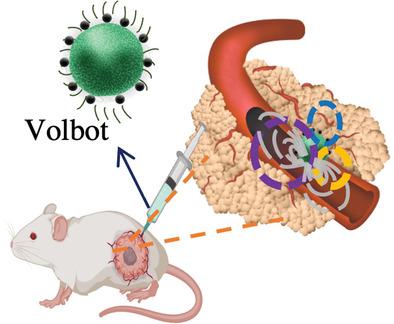当前位置:
X-MOL 学术
›
Adv. Funct. Mater.
›
论文详情
Our official English website, www.x-mol.net, welcomes your
feedback! (Note: you will need to create a separate account there.)
Volbots: Volvox Microalgae-Based Robots for Multimode Precision Imaging and Therapy
Advanced Functional Materials ( IF 18.5 ) Pub Date : 2022-06-19 , DOI: 10.1002/adfm.202201800 Jie Wang 1, 2 , Fernando Soto 1, 2 , Shiqin Liu 2 , Qingqing Yin 2 , Emma Purcell 1, 2 , Yitian Zeng 3 , En‐Chi Hsu 2 , Demir Akin 1, 2 , Bob Sinclair 3 , Tanya Stoyanova 2 , Utkan Demirci 1, 2
Advanced Functional Materials ( IF 18.5 ) Pub Date : 2022-06-19 , DOI: 10.1002/adfm.202201800 Jie Wang 1, 2 , Fernando Soto 1, 2 , Shiqin Liu 2 , Qingqing Yin 2 , Emma Purcell 1, 2 , Yitian Zeng 3 , En‐Chi Hsu 2 , Demir Akin 1, 2 , Bob Sinclair 3 , Tanya Stoyanova 2 , Utkan Demirci 1, 2
Affiliation

|
Biohybrid microrobotics are exploited as a delivery approach to actively transport therapeutic payload to tumors. However, the therapeutic utility of this approach can be diminished by tumor hypoxia. Moreover, current biohybrid microrobotics design is mainly focused on the living organisms’ motility and biocompatibility, yet the unique biological function of the natural organism is often overlooked. Here, an all-in-one self-propelled volvox-based multifunctional robot, that is, Volbot, with built-in capabilities of fluid mixing, multimode imaging, and photosynthesis-mediated in situ oxygen generation that can potentially relieve hypoxia is developed. Volbots can follow a pre-specified route and directionality under the control of a magnetic field. Red-light irradiation (λ = 650 nm) can enhance the Volbot's locomotive behavior, enhance the mixing of biofluids, and modulate the oxygen production to improve the efficacy of photodynamic therapy. Moreover, Volbots can absorb near-infrared irradiation and produce localized hyperthermia to treat tumors. Subcutaneous tumor suppression can be achieved by this high-yield oxygen-producing biohybrid “microfactory” in a photodynamic/photothermal-synergistic therapy strategy. Furthermore, Volbots also offer imaging capabilities and exhibit considerable promise as a multifunctional microrobotics-based theranostic approach for a precision tumor therapy strategy.
中文翻译:

Volbots:用于多模精密成像和治疗的基于 Volvox 微藻的机器人
生物混合微型机器人被用作一种将治疗有效载荷主动运送到肿瘤的递送方法。然而,这种方法的治疗效用会因肿瘤缺氧而减弱。此外,目前的生物混合微型机器人设计主要关注生物体的运动性和生物相容性,而往往忽视了自然生物体独特的生物学功能。在这里,开发了一种基于 volvox 的一体式自推进多功能机器人,即 Volbot,它具有内置的流体混合、多模式成像和光合作用介导的原位氧气生成功能,可以潜在地缓解缺氧。Volbots 可以在磁场的控制下遵循预先指定的路线和方向性。红光照射 (λ = 650 nm) 可以增强 Volbot 的机车行为,增强生物流体的混合,并调节氧气的产生以提高光动力疗法的功效。此外,Volbots 可以吸收近红外线辐射并产生局部热疗来治疗肿瘤。皮下肿瘤抑制可以通过这种高产氧生物混合“微工厂”在光动力/光热协同治疗策略中实现。此外,Volbots 还提供成像功能,并作为一种基于微型机器人的多功能治疗诊断方法用于精准肿瘤治疗策略,展现出相当大的前景。皮下肿瘤抑制可以通过这种高产氧生物混合“微工厂”在光动力/光热协同治疗策略中实现。此外,Volbots 还提供成像功能,并作为一种基于微型机器人的多功能治疗诊断方法用于精准肿瘤治疗策略,展现出相当大的前景。皮下肿瘤抑制可以通过这种高产氧生物混合“微工厂”在光动力/光热协同治疗策略中实现。此外,Volbots 还提供成像功能,并作为一种基于微型机器人的多功能治疗诊断方法用于精准肿瘤治疗策略,展现出相当大的前景。
更新日期:2022-06-19
中文翻译:

Volbots:用于多模精密成像和治疗的基于 Volvox 微藻的机器人
生物混合微型机器人被用作一种将治疗有效载荷主动运送到肿瘤的递送方法。然而,这种方法的治疗效用会因肿瘤缺氧而减弱。此外,目前的生物混合微型机器人设计主要关注生物体的运动性和生物相容性,而往往忽视了自然生物体独特的生物学功能。在这里,开发了一种基于 volvox 的一体式自推进多功能机器人,即 Volbot,它具有内置的流体混合、多模式成像和光合作用介导的原位氧气生成功能,可以潜在地缓解缺氧。Volbots 可以在磁场的控制下遵循预先指定的路线和方向性。红光照射 (λ = 650 nm) 可以增强 Volbot 的机车行为,增强生物流体的混合,并调节氧气的产生以提高光动力疗法的功效。此外,Volbots 可以吸收近红外线辐射并产生局部热疗来治疗肿瘤。皮下肿瘤抑制可以通过这种高产氧生物混合“微工厂”在光动力/光热协同治疗策略中实现。此外,Volbots 还提供成像功能,并作为一种基于微型机器人的多功能治疗诊断方法用于精准肿瘤治疗策略,展现出相当大的前景。皮下肿瘤抑制可以通过这种高产氧生物混合“微工厂”在光动力/光热协同治疗策略中实现。此外,Volbots 还提供成像功能,并作为一种基于微型机器人的多功能治疗诊断方法用于精准肿瘤治疗策略,展现出相当大的前景。皮下肿瘤抑制可以通过这种高产氧生物混合“微工厂”在光动力/光热协同治疗策略中实现。此外,Volbots 还提供成像功能,并作为一种基于微型机器人的多功能治疗诊断方法用于精准肿瘤治疗策略,展现出相当大的前景。











































 京公网安备 11010802027423号
京公网安备 11010802027423号